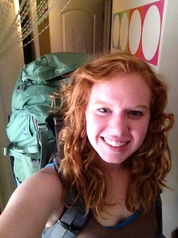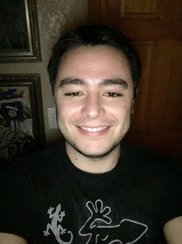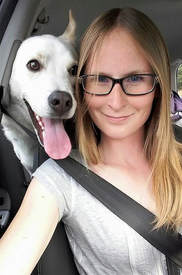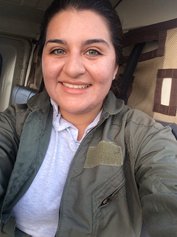The Evergreen State College
|
Tara Newman (MES program, 2016 - 2018)
Tara has always been drawn to animals and protecting the environment, and it only made sense for her to pursue a career in ecology. She graduated with a B.S. in Environmental Science (emphasis in Terrestrial Ecology) from Western Washington University in 2013. Her undergraduate projects included wildlife research on feeding behaviors of brant geese, forest structure and diversity assessments, water quality monitoring, environmental impact assessments, and salmon habitat restoration. Soon after graduating, Tara moved to Indiana to spend a year working for The Nature Conservancy in all aspects of habitat restoration and land management, gaining experience in on-the-ground implementation of conservation plans. Upon returning to Washington, she accepted a position with the Washington Department of Fish and Wildlife conducting wildlife surveys for amphibians, fish, birds, and vegetation in the Chehalis River floodplain. Tara continues to work for WDFW and graduated from MES in 2018 with a thesis titled "Changes in Water Associated Bird Abundance on Budd inlet and Capitol Lake, WA. From 1987 to 2017." Tara worked with John on a collaborative project with researchers from Oregon State University to examine potential effects of forest landowner decisions, in the face of climate change, on forest-dependent wildlife. She evaluated habitat associations for dozens of sensitive species in the Pacific Northwest and conducted spatial analyses on species ranges and FIA plots in ArcGIS. |
FIU students

Emily Brantner (M.S. 2015)
I’ve always enjoyed communing with nature, which led me down the path towards a career in Biology. While studying Biology at Messiah College, I took an animal behavior course that was taught by a tropical herpetologist and I fell in love with both frogs and the tropics. Since then, I have graduated with my bachelor’s in Biology, I have worked on an orchid farm while swabbing amphibians for chytrid fungus in Panama, and I spent a summer as a field technician working on the reintroduction of the Wyoming toad in Laramie, Wyoming.
As a Master's student at Florida International University, I worked on an analysis of critical habitat designations under the Endangered Species Act, specifically to what extent the current set of species with critical habitats represents the phylogenetic diversity of listed species as a whole.
After graduating in fall 2015 Emily starting working for the U.S. EPA's Office of the Science Advisor as a Scientific Integrity Outreach Support Associate in 2016.
I’ve always enjoyed communing with nature, which led me down the path towards a career in Biology. While studying Biology at Messiah College, I took an animal behavior course that was taught by a tropical herpetologist and I fell in love with both frogs and the tropics. Since then, I have graduated with my bachelor’s in Biology, I have worked on an orchid farm while swabbing amphibians for chytrid fungus in Panama, and I spent a summer as a field technician working on the reintroduction of the Wyoming toad in Laramie, Wyoming.
As a Master's student at Florida International University, I worked on an analysis of critical habitat designations under the Endangered Species Act, specifically to what extent the current set of species with critical habitats represents the phylogenetic diversity of listed species as a whole.
After graduating in fall 2015 Emily starting working for the U.S. EPA's Office of the Science Advisor as a Scientific Integrity Outreach Support Associate in 2016.
|
Elizabeth Lago (B.Sc. 2015)
Elizabeth discovered bird banding as a Marine Biology student in Florida International University (FIU). As she carefully extracted warblers and gray catbirds from mist nets, she found myself mesmerized by how these small creatures can tell us big stories about their environments. Soon after, she became project manager for the bird-window collision project and began volunteering at the Cape Florida banding station. In 2015, Elizabeth graduated from FIU with a Bachelor of Science in Marine Biology. Her birding experience kept growing as she joined Audubon’s Christmas Bird Counts and created (and conducted) a weekly bird survey for Museum Volunteers for the Environment (MUVE). She also worked in the field to monitor the endangered Cape Sable seaside sparrow in the Everglades. Currently, she is a spoonbill intern for Biscayne National Park, Everglades National Park, and the Everglades Science Center at Tavernier, and will be mapping roseate spoonbill (Platalea ajaja) nesting distributions. In the fall of 2017, Elizabeth will begin to study the local and regional dispersal of spoonbills using satellite telemetry as a Master of Environmental Science student in Florida Atlantic University. |

Gabriel de la Iglesia (B.Sc. 2015)
Initially captivated by anything that scurried by during my many adventures as a young naturalist in Puerto Rico, my interest in birds truly blossomed during my last years as an undergraduate at Florida International University (FIU). I performed surveys examining the window collision rates suffered by migratory birds, based upon characteristics of the study buildings on the FIU campus. Although this multi-year study forced me to face the scale of the destruction, it also helped me realize how fascinating and beautiful birds are. Now I strive to mitigate any negative effects urbanization imposes on birds, in order to ensure that iconic and beautiful songbirds persist well into the future.
After graduating from FIU in 2015 with my Bachelor of Science in Biology (B.Sc.), I started working on my Master of Science in Biology at Western Carolina University (WCU). I am currently focusing my efforts on understanding the fitness consequences incurred upon Eastern Bluebird (Sialia sialis) nestlings that hatch in disturbed, urban areas. As the world’s human population continues to increase and human development follows in tandem, so do habitat fragmentation and environmental degradation. Therefore, I want my research to help implementation of successful conservation measures in the future.
Initially captivated by anything that scurried by during my many adventures as a young naturalist in Puerto Rico, my interest in birds truly blossomed during my last years as an undergraduate at Florida International University (FIU). I performed surveys examining the window collision rates suffered by migratory birds, based upon characteristics of the study buildings on the FIU campus. Although this multi-year study forced me to face the scale of the destruction, it also helped me realize how fascinating and beautiful birds are. Now I strive to mitigate any negative effects urbanization imposes on birds, in order to ensure that iconic and beautiful songbirds persist well into the future.
After graduating from FIU in 2015 with my Bachelor of Science in Biology (B.Sc.), I started working on my Master of Science in Biology at Western Carolina University (WCU). I am currently focusing my efforts on understanding the fitness consequences incurred upon Eastern Bluebird (Sialia sialis) nestlings that hatch in disturbed, urban areas. As the world’s human population continues to increase and human development follows in tandem, so do habitat fragmentation and environmental degradation. Therefore, I want my research to help implementation of successful conservation measures in the future.


